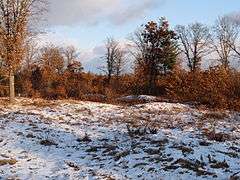Cranberry Creek Archeological District
|
Cranberry Creek Archeological District | |
|
Cranberry Creek Archaeological District | |
| Nearest city | New Miner, Wisconsin |
|---|---|
| Area | 140 acres (57 ha) |
| NRHP Reference # | 84003689[1] |
| Added to NRHP | July 19, 1984 |
Cranberry Creek Archeological District, also known as Cranberry Creek Mound Group, is an ancient American Indian burial mound site from circa AD 100–800 near New Miner, Wisconsin, United States. It is three miles east of Necedah National Wildlife Refuge in Juneau County.[2] It is part of the "effigy mound culture" of native peoples in Wisconsin, who practiced the "respectful burial of their dead".[3]
Humans first inhabited Wisconsin about 12,000 years ago, and the use of burial mounds developed in between 500 BC to 1000 AD during what is referred to as the Woodland period. The burial mounds during the late Woodland period tended to be built as effigies of birds, bears, and panthers, and examples of these can be found in the Cranberry Creek Archeological District.[3] As with other burial mounds on state property, the mounds in this region are protected against unauthorized disturbance.[3][4] Many of the best examples of mounds in this area are on the east side of Cranberry Creek. In addition to effigies, conical, linear, and oval mounds are found. Although archeological studies have been conducted here since 1917, and farming has damaged parts of the northern cluster, the cluster in the southern section is essentially unaltered by modern man.[5] Cranberry Creek Archeological District encompasses one of the larger mound groups in Wisconsin with over 300 mounds,[4] and possibly up to 500 mounds.[6]
Cranberry Creek Mound Group is owned by the Wisconsin Department of Natural Resources, and covers 675 acres (273 ha). The area is heavily forested, containing river birch, silver maple, red maple, jack pine, and oak. It is a State Natural Area since 1986.[5][7]
In addition to the Cranberry Creek Archeological District, Juneau County has two other related National Register of Historic Places: Gee's Slough Mound Group (ref: 78000108), which is also from the Woodland culture, and Lemonweir Glyphs (ref: 93001173).[1][8]
See also
References
- 1 2 National Park Service (July 9, 2010). "National Register Information System". National Register of Historic Places. National Park Service.
- ↑ "Chapter 3: Refuge Environment". Necedah National Wildlife Refuge Comprehensive Conservation Plan (PDF). Washington, D.C.: U.S. Fish and Wildlife Service. p. 23. Retrieved January 27, 2012.
- 1 2 3 "Burial Mounds in Wisconsin". Wisconsin Department of Natural Resources. Retrieved January 27, 2012.
- 1 2 Birmingham, Robert A.; Leslie E. Eisenberg (2000). Indian Mounds of Wisconsin. Madison, WI: University of Wisconsin Press. pp. 6, 110. ISBN 978-0-299-16874-2. Retrieved January 27, 2012.
- 1 2 "Cranberry Creek Mound Group (No. 203)". Wisconsin Department of Natural Resources. Retrieved January 27, 2012.
- ↑ Ostergren, Robert Clifford; Thomas R. Vale (1997). Wisconsin Land and Life. Madison, WI: University of Wisconsin Press. pp. 341–344, 350. ISBN 978-0-299-15350-2. Retrieved January 27, 2012.
- ↑ "Cranberry Creek Mound Group State Natural Area". Great Wisconsin and Birding Trail. Retrieved January 27, 2012.
- ↑ "New Lisbon Chamber of Commerce". Native American Effigy Mounds. Retrieved January 27, 2012.
Further reading
- Boszhardt, Robert F. (1987). Mapping Mounds in the Cranberry Creek Archaeological District Year 1: An Example of Cooperative Archaeology in Wisconsin. Madison, WI: Mississippi Valley Archaeological Center at the University of Wisconsin-La Crosse. OCLC 27403160.
| Wikivoyage has a travel guide for Necedah. |
